Task: Case "Development of a project team"
Based on the following case study, written by Gina Abudi, analyse the process of the team's development with reference to Tuckman's development stages. With the knowledge that you have acquired, think about what a team coach could do to support the team's development in each of these phases. Give feedback aimed at enhancing team performance with specific recommendations. Note down your results in your learning journal.
Background and team members
A team has been pulled together from various parts of a large service organisation to work on a new project with the aim of improving how the company manages and supports its client base. The team lead on this project is Sandra from the Chicago office who has 15 years’ experience as a project manager/team lead managing process improvement projects.
The other members of the team include:
- Peter: 10 years’ experience on various types of projects, expertise in scheduling and budget control (office location: San Diego)
- Sarah: 5 years’ experience as an individual contributor to projects, strong programming background, some experience developing databases (office location: Chicago)
- Mohammed: 8 years’ experience working on various projects, expertise in earned value management, stakeholder analysis and problem solving (office location: New York)
- Donna: 2 years’ experience as an individual contributor to projects (office location: New York)
- Ameya: 7 years’ experience in process improvement projects, background in developing databases, expertise in earned value management (office location: San Diego)
Sandra has worked on projects with Sarah and Mohammed, but has never worked with the others. Donna has worked with Mohammed. No one else has worked with any other members of this team. Sandra has been given a very tight deadline to get this project completed.
Sandra has decided that it would be best if the team met face-to-face initially, even though they will be working virtually for the project. She has arranged a meeting at the New York office (company headquarters) for the entire team. They will spend 2 days getting introduced to each other and learning about the project.
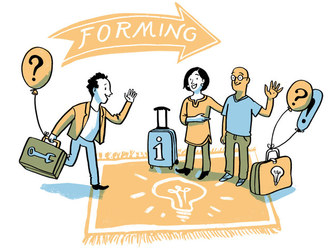
The initial meeting (Stage 1: Forming)
The day of the face-to-face meeting in New York has arrived. All team members are present. The agenda includes:
- Personal introductions
- Team building exercises
- Information on the process improvement project
- Discussion around team roles and responsibilities
- Discussion around team norms for working together
- Introduction on how to use the SharePoint site that will be used for this project to share ideas, brainstorm, store project documentation, etc.
The team members are very excited to meet each other. All of them has heard of the other members, although they have not worked together as a team before. They believe they each bring value to this project. The team building exercises have gone well; everyone participated and seemed to enjoy the exercises. While there was some discussion around roles and responsibilities – with team members vying for “key” positions on the team – overall there was agreement on what needed to get done and who was responsible for particular components of the project.
The onsite meeting goes well. The team members get to know each other and discuss their personal lives outside of work – hobbies, family, etc. Sandra believes this is a great sign that they will get along well – they are engaged with each other and genuinely seem to like each other!
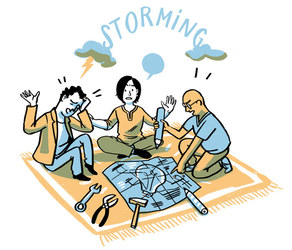
The project work begins (Stage 2: Storming)
The team members have gone back to their home offices to begin work on their project. They interact via the SharePoint site and the project is off to a good start. And then, the arguments begin...
Peter has put up the project schedule based on conversations with only Mohammed and Ameya on the team. Donna and Sarah feel as if their input to the schedule was not properly considered. They believe that because they are more junior members of the team, Peter has completely disregarded their concerns about the timeline for the project. They then challenged Peter’s schedule, stating that it was impossible to achieve, and was setting up the team for failure. At the same time, Sarah argued with Ameya over who should lead the database design and development effort for this project. While Sarah acknowledges that Ameya has a few years more experience than she does in database development, she only agreed to be on this project in order to take a lead role and develop her skills further so that she could advance at the company. If she had known that Ameya was going to be the lead, she wouldn’t have volunteered to join this project team. Additionally, Mohammed appears to be off and running on his own, while at the same time neither keeping the others informed regarding his progress nor updating his information on the SharePoint site. No one really knows what he has been working on or how much progress is being made.
Sandra had initially taken a side role during these exchanges, hoping that the team would work it out for themselves. However, she understands from past experience managing many project teams that it is important for her to take control and guide the team through this difficult time. She convenes all of the team members for a virtual meeting to reiterate their roles and responsibilities (which were agreed in the kick-off meeting) and to ensure that they understand the goals and objectives of the project. She then made some decisions when the team couldn’t come to agreement. She determined that Ameya would lead the database development design component of the project, working closely with Sarah so that she can develop further experience in this area. Also, she reviewed the schedule that Peter created with the team, making adjustments where necessary to address the concerns of Donna and Sarah. She reminded Mohammed that this was a team effort and that he needed to work closely with the others on the team.
During the virtual meeting session, Sandra referred back to the ground rules the team set in their face-to-face meeting and worked with the team to ensure that there was a plan in place for how decisions are made on the team and who has responsibility for making decisions.
Over the next few weeks, Sandra noticed that arguments/ disagreements were kept at a minimum and when they did occur, they were worked out quickly by the team, without her involvement being necessary. Still, she monitored how things were going and held regular virtual meetings to ensure the team was moving in the right direction. On a monthly basis, Sandra brings the team together for a face-to-face meeting. As the working relationships of the team members started to improve, Sandra began to see significant progress on the project.
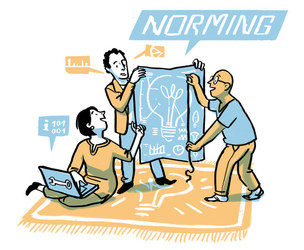
All is going smoothly (Stage 3: Norming)
The team has now been working together for nearly 3 months. There is definitely a sense of teamwork among the group. There are few arguments and disagreements that can’t be resolved among the team. They support each other on the project – for example when solving problems, making decisions as a team, sharing information and ensuring that the ground rules put in place for the team are followed.
Additionally, the team members help each other to grow and develop their skills. For example, Ameya has worked closely with Sarah to teach her many of the skills he has learned in database design and development and she has been able to take the lead on accomplishing some of the components of their part of the project.
Overall, the team members are becoming friends. They enjoy each other’s company – both while working on the project and after hours via email, instant messaging, Twitter, or over the telephone.
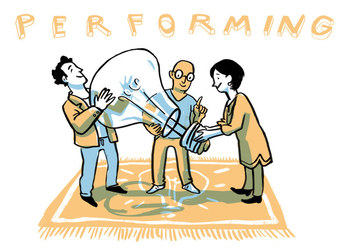
Significant progress is made! (Stage 4: Performing)
The team is now considered a "high performing team". It wasn’t easy to get to this stage, but they made it! They work effectively as a group – supporting each other and relying on the group as a whole to make decisions on the project. They can brainstorm effectively to solve problems and are highly motivated to reach the end goal as a group. When there is conflict on the team – such as a disagreement on how to go about accomplishing a task – the group is able to work it out on their own without relying on the team leader to intervene and make decisions for them. The more junior members – Donna and Sarah – have really developed their skills with the support and help of the others. They have taken on leadership roles for some components of the project.
Sandra checks in with the team – praising them for their hard work and their progress. The team celebrates the milestones reached along the way. When necessary, Sandra provides a link from the team to the executives for decisions that need to come from higher up or when additional support is needed.
The project is on time and within budget. Milestones are being met – some are even ahead of schedule. The team is pleased with how well the project is going, as is Sandra and the executives of the organisation.
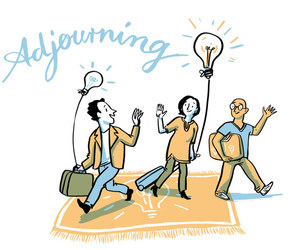
Time to wrap up (Stage 5: Adjourning)
The project has ended. It was a huge success! The internal customer is pleased and there is definitely an improvement in how the company supports its clients. It has been a great eight months working together…with some ups and downs of course. Each of the individuals on the project will be moving to other projects within the organization, but no one is going to be on the same project. They will miss working with each other but have vowed to remain friends and keep in touch on a personal level – hopefully they will work together again soon!
The team has come together in the New York office to discuss the project, including documenting best practices and discussing what worked effectively and what they would improve upon given the chance to do it again. Sandra has taken the team out to dinner. They are joined by the project sponsor and some other executives who are extremely pleased with the end result.
The End!
This is a simplistic view of a team working through the five stages of team development. I hope it provides some benefit to you.
Remember that at any time this team was able to revert back to a previous stage. Let’s assume that another individual joins the team – the team will revert back to the “forming” stage as they learn how to work with the new team member, re-establishing team guidelines, finding their way again, and learning how to work cohesively as a team. Or, let’s assume that Mohammed slips back into his old ways of keeping to himself and not sharing information with the team – this may cause the team to revert back to the "storming" stage.
It is important to remember that every team – regardless of what the team is working on – will follow these stages of team development. It is the job of the team leader to help see the team through these stages; to bring them to the point where they are working as effectively as possible toward a common goal.
Source: Abudi, Gina (2016). The five stages of project team development. https://project-management.com/the-five-stages-of-project-team-development (accessed on 30.10.2020, used with permission).
Having completed this task, click on the following link to view a possible answer.
Show / hide sample answer
Here is Olesia's feedback to the team of the case study:
Forming: During this phase as a coach I would recommend to establish better communication and try to build trust among the team members. All the developments described in this phase I find relevant, so far everything is going seamless.
Storming: This phase is a real challenge, so it would be recommended that the team leader helps to resolve misunderstanding and other types of communication issues, so that emerging conflicts won’t escalate. As a coach I would also suggest that team members express their concerns and try to communicate on terms of mutual respect and understanding.
Norming: All the developments at this phase are inherent to the phase description. As a coach I would recommend to keep moving in the same direction and enjoy the effective results.
Performing: This phase shows how successfully established relationships between team members affect the project and bring brilliant results. As a coach I would be satisfied with the described situation.
Adjourning: The final phase is almost always a bit painful if the team-members have achieved mutual understanding and the team functions efficiently as a single entity. It is wonderful to see how this team coped with all obstacles. As a coach I would have been very satisfied with the team’s functioning and their work results.
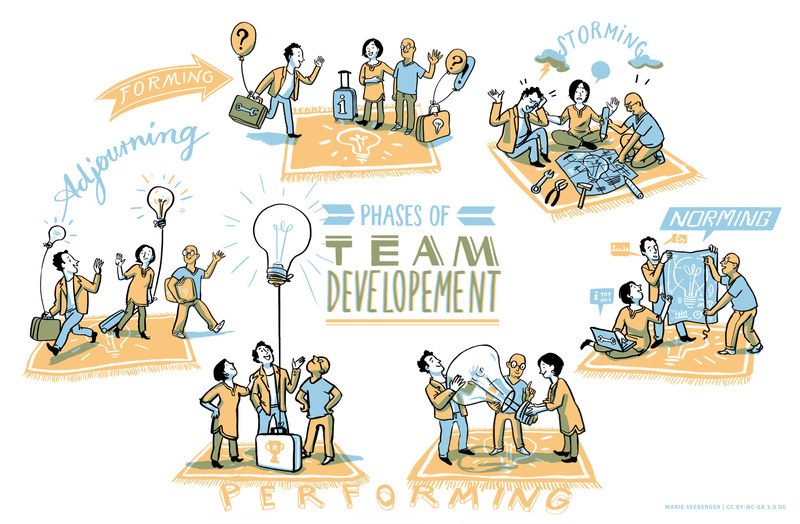
Illustration by Marie Seeberger (http://www.behance.net/marieseeberger) CC-BY-NC-SA 3.0 license